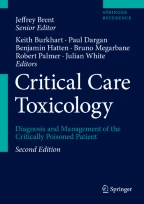Centrally Acting Muscle Relaxants

The centrally acting muscle relaxants are a group of drugs that act in the central nervous system (CNS) to mitigate tension and spasm of skeletal muscles. Drugs within this group are structurally heterogeneous and act at a variety of receptors in the CNS. Muscle relaxants that act at the level of the spinal cord, such as baclofen, or peripherally, such as dantrolene, are discussed in their respective chapters.
This is a preview of subscription content, log in via an institution to check access.
Access this chapter
Subscribe and save
Springer+ Basic
€32.70 /Month
- Get 10 units per month
- Download Article/Chapter or eBook
- 1 Unit = 1 Article or 1 Chapter
- Cancel anytime
Buy Now
Price includes VAT (France)
eBook EUR 353.09 Price includes VAT (France)
Hardcover Book EUR 348.14 Price includes VAT (France)
Tax calculation will be finalised at checkout
Purchases are for personal use only
Similar content being viewed by others

Centrally Acting Muscle Relaxants
Chapter © 2016

Muscle Relaxants
Chapter © 2017

Benzodiazepines and Muscle Relaxants
Chapter © 2015
References
- Berger FM, Kletzkin M, Ludwig BJ, et al. Unusual s properties of N-isopropyl-2-methyl-2-propyl-1,3-propanediol dicarbamate (carisoprodol). J Pharmacol Exp Ther. 1959;127:66–74. CASPubMedGoogle Scholar
- Roberge RJ, Lin E, Krenzelok EP. Flumazenil reversal of carisoprodol (Soma) intoxication. J Emerg Med. 2000;18:61–4. ArticleCASPubMedGoogle Scholar
- Council on Drugs. New and non-official drugs: chlorzoxazone (Paraflex). JAMA. 1959;170:195. Google Scholar
- Roberge RJ, Atchley B, Ryan K, Krenzelok EP. Two chlorzoxazone (Parafon forte) overdoses and coma in one patient: reversal with flumazenil. Am J Emerg Med. 1998;16:393–5. ArticleCASPubMedGoogle Scholar
- Li JR. Methocarbamol in the treatment of black widow spider poisoning. JAMA. 1960;173:662. ArticleCASGoogle Scholar
- Leventen EO, Vaccarino FP. Intravenous methocarbamol in 100 orthopaedic patients. Curr Ther Res. 1960;2:497–500. CASPubMedGoogle Scholar
- O’Neil MJ, Smith A, Heckelman PE, Obenchain JR, editors. The Merck index: an encyclopedia of chemicals, drugs, and biologicals. 13th ed. Whitehouse Station: Merck & Co; 2001. Google Scholar
- DiFrancesco A. Diazepam, a new tranquilizer. Am J Psychiatry. 1963;119:989–90. ArticleCASPubMedGoogle Scholar
- Baselt RC. Disposition of toxic drugs and chemicals in man. Foster City: Chemical Toxicology Institute; 2000. Google Scholar
- Fathie K. A second look at a skeletal muscle relaxant: a double-blind study of metaxalone. Curr Ther Res. 1964;6:677–83. CASPubMedGoogle Scholar
- Ashby P, Burke D, Rao S, Jones RF. Assessment of cyclobenzaprine in treatment of spasticity. J Neurol Neurosurg Psychiatry. 1972;35:599–605. ArticleCASPubMedPubMed CentralGoogle Scholar
- Share NN, McFarlane CS. Cyclobenzaprine: a novel centrally acting skeletal muscle relaxant. Neuropharmacology. 1975;14:675–84. ArticleCASPubMedGoogle Scholar
- Reeves RR, Burke RS. Carisoprodol: abuse potential and withdrawal syndrome. Curr Drug Abuse Rev. 2010;3(1):33–8. ArticleCASPubMedGoogle Scholar
- Lebby TI, Dugger K, Lipscomb JW, Leikin JB. Skeletal muscle relaxant ingestion. Vet Hum Toxicol. 1990;32:133–5. CASPubMedGoogle Scholar
- Slordal L, Gjerden P. Orphenadrine [letter]. Br J Psychiatry. 1999;174:275–6. CASPubMedGoogle Scholar
- Leikin JB, Paloucek FP, editors. Poisoning & toxicology compendium. Hudson: Lexi-Comp; 1998. Google Scholar
- Data on file, Flexeril (cyclobenzaprine). West Point: Merck & Co; 1999 Google Scholar
- Data on file, Skelaxin (metaxalone). Cedar Knolls: Carnrick Laboratories; 1998. Google Scholar
- Logan BK, Case GA, Gordon AM. Carisoprodol, meprobamate, and driving impairment. J Forensic Sci. 2000;45:619–23. CASPubMedGoogle Scholar
- Davis GG, Alexander CB. A review of carisoprodol deaths in Jefferson County, Alabama. South Med J. 1998;91:726–30. ArticleCASPubMedGoogle Scholar
- Reeves RR, Liberto V. Abuse of combinations of carisoprodol and tramadol. South Med J. 2001;94:512–4. ArticleCASPubMedGoogle Scholar
- Roth BA, Vinson DR, Kim S. Carisoprodol-induced myoclonic encephalopathy. J Toxicol Clin Toxicol. 1998;36:609–12. ArticleCASPubMedGoogle Scholar
- Spiller HA, Winter ML, Mann KV, et al. Five-year multicenter retrospective review of cyclobenzaprine toxicity. J Emerg Med. 1995;13:781–5. ArticleCASPubMedGoogle Scholar
- Danze LK, Langdorf MI. Reversal of orphenadrine-induced ventricular tachycardia with physostigmine. J Emerg Med. 1991;9:453–7. ArticleCASPubMedGoogle Scholar
- Van Herreweghe I, Mertens K, Maes V, Ramet J. Orphenadrine poisoning in a child: clinical and analytical data. Intensive Care Med. 1999;25:1134–6. ArticlePubMedGoogle Scholar
- Jacobsen D, Wiik-Larsen E, Saltvedt E, Bredesen JE. Meprobamate kinetics during and after terminated hemoperfusion in acute intoxications. J Toxicol Clin Toxicol. 1987;25:317–31. ArticleCASPubMedGoogle Scholar
- Charron C, Mekontso-Dessap A, Chergui K, Rabiller A, Jardin F, Vieillard-Baron A. Incidence, causes and prognosis of hypotension related to meprobamate poisoning. Intensive Care Med. 2005;31(11):1582–6. ArticlePubMedGoogle Scholar
- Buire AC, Vitry F, Hoizey G, Lamiable D, Trenque T. Overdose of meprobamate: plasma concentration and Glasgow Coma Scale. Br J Clin Pharmacol. 2009;68(1):126–7. ArticlePubMedPubMed CentralGoogle Scholar
- Wyller TB, Korsmo G, Gadeholt G. Dependence on carisoprodol (Somadril)? A prospective withdrawal study among prisoners. Tidsskr Nor Laegeforen. 1991;111:193–5. CASPubMedGoogle Scholar
- Reeves RR, Beddingfield JJ, Mack JE. Carisoprodol withdrawal syndrome. Pharmacother J Hum Pharmacol Drug Ther. 2004;24(12):1804–6. ArticleGoogle Scholar
- Matos ME, Burns MM, Shannon MW. False-positive tricyclic antidepressant drug screen results leading to the diagnosis of carbamazepine intoxication. Pediatrics. 2000;105(5):E66. ArticleCASPubMedGoogle Scholar
Author information
Authors and Affiliations
- Pediatrics and Department to Pediatric Emergency Medicine, Yale University, New Haven, CT, USA Madeline L. McCarthy
- Pediatrics and Department to Pediatric Emergency Medicine and Medical Toxicology, Yale University, New Haven, CT, USA Carl R. Baum
- Madeline L. McCarthy

